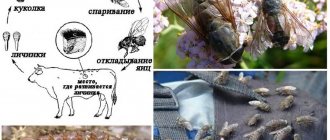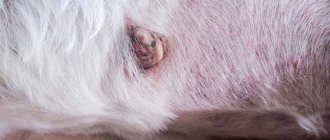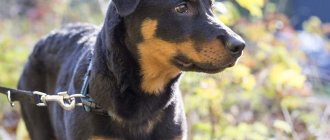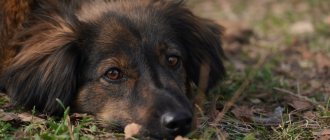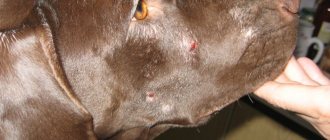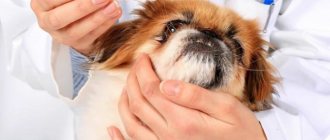Alena Igorevna Goncharenko
veterinarian Petstory
Finding a lump in a dog is always a cause for concern for the owner. If you notice any lumps on your animal’s body, you should be examined by a veterinarian as soon as possible. Delaying the diagnosis can negatively affect treatment, since many formations only increase over time and grow into other organs.
Eczema
Eczema is an inflammation of the superficial layer of the skin. It can be dry or weeping, focal (limited) or diffuse (scattered).
It begins with redness, the formation of compacted elevations (papules), turning into bubbles with liquid (vesicles). The vesicular exudate then becomes purulent and bursts, infecting the surrounding surface and causing maceration.
CAUSES:
- poor skin and coat care;
- use of unsuitable cleaning products;
- ectoparasites - lice, ticks, fleas;
- mechanical impact - rubbing the skin with a collar, muzzle, harness;
- chemicals - medicines, disinfectants.
Veterinary diagnostics
A visit to the veterinary clinic is necessary if there are accompanying symptoms, a frightening appearance of the lump, or discomfort when palpating it. Before visiting the doctor, do not allow your dog to lick or scratch the affected area. This may worsen his condition.
To make a diagnosis, urine and blood tests are taken from the four-legged patient. He also undergoes X-ray, ultrasound, CT and biopsy. These studies help determine the exact size, location, depth and possible malignancy of the tumor. In the early stages, endoscopy is recommended.
Neoplasms
Tumors in dogs can be benign or malignant. It is very important to carry out correct diagnosis in a timely manner.
Benign
Benign cells retain the ability to differentiate, grow slowly, and never grow into surrounding tissues.
THE MOST COMMON BENIGN NEOPLASMS:
- Lipoma - a wen - is of soft consistency, painless, and easily movable. Develops in subcutaneous fatty tissue.
- Fibroma - can cause a feeling of fullness and aching pain. Occurs on the skin and mucous membranes.
- Adenoma is a growth of glandular epithelium. In older dogs it often appears in the perianal area. Associated with hormonal imbalance and increased androgen levels.
- Papilloma is a growth of the epidermis that occurs in aging animals. The main localization is paws, eyelids, head.
Malignant
They are formed from uncontrollably dividing cells and are characterized by a lack of cell differentiation, germination into adjacent areas, and metastasis to distant organs.
MOST COMMON:
- melanoma;
- carcinoma;
- sarcoma.
Causes of subcutaneous formations
Lumps under a dog's skin are not always associated with cancer. Most of them occur for the following reasons:
- Insect bites
. Swelling on the nose often remains after an unsuccessful encounter with bees. Their bites are always accompanied by redness and swelling.
- Mechanical injury
. After an unsuccessful jump for the ball and a not at all soft landing right into the wall, a bump may appear on the face of the unlucky pet.
- Infection
. With a weakened immune system, balls filled with pus often appear. This occurs due to infection by bacteria that cause inflammation. A virus can also cause compaction.
- Inflammation of the paraanal glands
. If a lump is found under a dog’s tail, then its appearance is affected by the inflammatory process. The affected area will be itchy and painful.
- Injection
. Swelling on the thigh or paw that occurs after vaccination is a natural reaction to the injected drug. After some time it goes away on its own.
- Tick infestation
. The attached parasite can be found on the stomach, side, chest, ear, chin and even under the eye. A mysterious growth that appeared shortly after a walk requires mandatory diagnosis. Some ticks carry deadly diseases.
Disorder of the functioning of the sebaceous glands and hair follicles. When the ducts are blocked, the secreted secretion accumulates inside the gland or follicle, leading to their growth.
The prolonged presence of swelling, accompanied by its increase and the appearance of pain, requires mandatory intervention by a veterinarian. Also, other alarming symptoms that are not directly related to education may be a reason for contacting.
Hernias
Hernia is the prolapse of the omentum, uterus, or part of the intestine under the skin. When internal organs prolapse through the umbilical ring - an umbilical hernia, through the inguinal canal - an inguinal hernia. It can be congenital or acquired, infringed or not infringed.
Outwardly it looks like a protrusion in the navel or groin area. Can reach significant sizes.
Congenital umbilical lesions are common in puppies and are sometimes treated conservatively.
Infringement of the uterus or intestines by a hernial ring is fraught with peritonitis and sepsis and requires immediate surgical intervention.
It would be a mistake to believe that only malignant tumors pose a danger to the life of an animal. No less serious, for example, are abscess and phlegmon, often leading to death.
Any skin seal requires careful diagnosis and proper treatment. Only a veterinarian can diagnose the disease and determine the tactics for its management.
What symptoms may appear?
Not all balls appear under the dog's skin. Some of them are formed in soft tissues and can be diagnosed only by palpation of the affected area. Because of this, it is important to be aware of your symptoms. Alarming symptoms include:
- pain when palpating the lump;
- change in color of adjacent tissues;
- stable tumor increase;
- worsening sleep, loss of activity and appetite;
- opening of the emerging papule with subsequent release of pus or blood;
- presence of temperature.
In the absence of the listed symptoms, but the formation persists for more than 7 days, it is recommended to undergo diagnostics at a veterinary clinic. If your pet has at least one of the listed symptoms, make an appointment immediately after detecting it.
Where to go? Which clinic will help?
Moscow
- State Vet . One of the Moscow clinics with an impeccable reputation. An examination by a specialist is only 400 rubles. There is a 50% discount during happy hours, 15% for inviting a friend, call for details. Address: metro station Bratislavskaya, Bratislavskaya street, 22.
- Vetlife . Clinic with modern veterinary equipment. A veterinary pharmacy and a grooming salon are also at your service. Initial appointment is 600 rubles. Address: Beskudnikovsky Boulevard, 12.
- Vega . The Vega network of veterinary clinics began its existence in St. Petersburg. A branch has recently been opened in Moscow. There is a 40% discount on medical examinations for older cats and dogs. Initial appointment is 765 rubles, appointment with a dermatologist is 1500 rubles. Address: Marshal Katukova Street, 17k1, 2nd floor.
Saint Petersburg
- Chelsea . Veterinary clinic with excellent reviews. Animal owners note the high professionalism of veterinarians and groomers, and the responsiveness of administrators. The clinic offers a 10% discount on services on Tuesdays and Fridays. Specialists carry out home visits, cost from 1000 rubles. Address: Budapestskaya street, 36k2, ground floor.
- Vetmir . Modern clinic with good equipment. The reviews note that the clinic’s doctors are not only highly qualified specialists, but also good psychologists. They easily find contact with animals, explain in detail the tactics of action and prognoses for further treatment. Admission costs from 500 rubles. Address: Komendantsky Prospekt, 51 k1, ground floor.
- Clinic Bars . The initial appointment is only 290 rubles. Wide range of veterinary procedures. The staff is very friendly and takes their work responsibly. Address: Alexandra Matrosova street, 9, 1st floor.
Krasnodar
- Help paw . The clinic has modern equipment and conducts laboratory tests. There is a hospital and a pet hotel. The owners praise the staff for their simple human attitude, responsiveness and quality work done. Initial appointment is 300 rubles. Address: Architect Ishunin Street, 7/1 bldg.
- Nika Clinic . The extensive experience of our specialists allows us to quickly and accurately carry out only the necessary research. You can call a veterinarian at home. Stavropolskaya, 107/10, ground floor.
- Veterinary site . The clinic carries out laboratory tests. It has its own pharmacy, which is very convenient for owners leaving the reception. Address: Zavodovskogo, 23, ground floor; entrance from the street Komarova.
- Clinic "Na Babushkina" . Has been carrying out its work for more than 20 years. The clinic’s veterinarians are guided by the principles of evidence-based medicine. Address: Babushkina street, 160.
Quantity
Treatment of cones in dogs
Treatment will always depend on the type of formation. Most cases are benign tumors
do not require treatment.
Histiocytomas
go away on their own within a month.
Lipomas
can grow to quite large sizes and make it difficult for your pet to walk, lie down, and generally move around.
If the lipoma grows quickly, it is better to remove it. Papillomas and adenomas
do not increase in size and quite rarely interfere in any way. In some places on the body, they may be subject to constant trauma, causing them to become infected and bleed, in which case it is better to remove them.
Treatment of malignant tumors
depends on many factors and is selected individually by the oncologist. The type and size of the tumor, its location, the stage of the oncological process, and the presence of metastases are taken into account. Surgical excision of the formation, chemotherapy, and radiation therapy can be used.
Treatment of abscesses
consists of clearing the cavity of pus, installing drains to drain the resulting fluid from the cavity, and using antimicrobial drugs locally and systemically.
Allergic reactions
are treated with antihistamines and, if necessary, hormonal medications.
Hernias
can only be treated surgically.
Contrary to popular belief, no folk remedies can help with hernias; without surgery, it is impossible to set the organs in the right place and sutured the hernia ring. Enlarged lymph nodes
are only a symptom of some pathological process in the body; it is necessary to find out the cause and direct treatment to it.
Cysts, adenomas and adenocarcinomas of the sebaceous glands
Sebaceous cysts are common types of skin cysts that contain sebum, a thick, oily material typically found in the skin around hair follicles.
These formations can be on any part of the body. Sebaceous cysts are benign, but they can also be mistaken for a malignant tumor called sebaceous adenocarcinoma or a benign growth called sebaceous adenoma.
If the cyst is not bothering your dog, your veterinarian can leave him alone, but if necessary, the cyst can be removed surgically.
Once removed, the cyst should be sent to a laboratory so that a veterinary pathologist can determine that it is indeed just a sebaceous cyst, adenoma, or adenocarcinoma, which may require additional treatment.
Prevention
Unfortunately, there is no prevention for most tumors. The exact reasons for their appearance have not yet been established; it is believed that ultraviolet and ionizing radiation, poor ecology and other factors that are extremely difficult to exclude from a pet’s life play a role in their development. Breast tumors can be prevented. There are studies according to which females spayed before their first heat have a less than 0.05% chance of developing such a malignant tumor. Then, with each heat, this percentage increases. Castration after the age of two years does not reduce the risk of developing neoplasms. Also, eliminating the use of hormonal medications to stop estrus reduces the risk of developing cancer.
Abscesses can be prevented by avoiding self-walking and fights between dogs. It is impossible to predict the development of an allergic reaction to something. But if the allergen is known, then contact of the dog with it should be excluded. Hernias are often congenital, which cannot be prevented. But traumatic hernias can be avoided if you always keep an eye on your pet while walking.
Cancerous lumps
This is visually unnoticeable. Found during examination, combing, bathing. Seals are removed surgically. The pet requires treatment.
A tumor develops by using the body's resources. Cells change structure. The tissue begins to multiply and grow. The tissue looks like ulcers or bumps.
Some breeds are at risk of cancer. These are boxers, mastiffs, terriers, and retrievers. The patient loses his appetite and moves little. The affected area smells unpleasant.
Also, the affected area sometimes bleeds. At the same time, the pet begins to move differently. The swallowing reflex is difficult. Doctors' intervention is required.
Why do wen form?
There is no reliable information about the causes of lipoma formation. But there are a number of provoking factors that can become a trigger. Among them:
- metabolic disorders;
- physical inactivity, limitation of space, which can cause excess weight;
- dog's age;
- liver and gallbladder dysfunction;
- improper feeding and obesity;
- genetic predisposition;
- gender of the animal.
For owners of dogs whose fatty tissue is a naturally inherited condition, you need to be aware of this feature and be prepared for the appearance of a lipoma. But do not discount the possibility of the appearance of other neoplasms (liposarcoma) and still, visit a veterinarian at the RosVet VC to make sure that the skin formation is safe.

